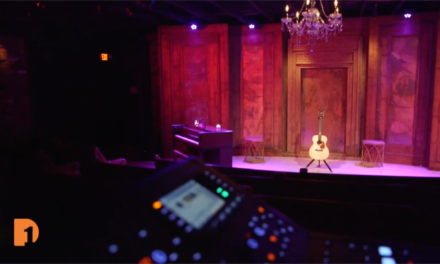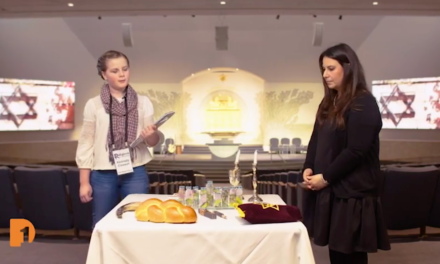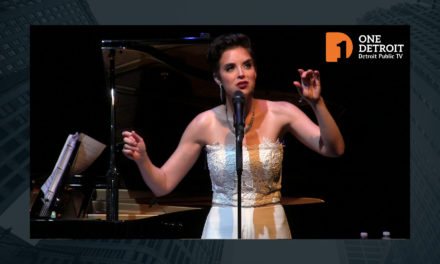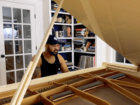Musician and visual artist, Karianne Spens-Hanna, knows how art therapy can heal. She uses her expertise to help young people at the Macomb County Juvenile Justice Center use art to externalize things they might hold inside.
Video Transcript:
DJ Oliver: Let’s check out musician and visual artist Karianne Spens-Hanna.
Karianne Spens-Hanna: I had a woman reach out to me who I went to high school with and she said that she was playing some of my music that I had just performed for a front porch concert series earlier in the day and unbeknownst to her, her kids were listening. And one of her children has autism, and usually Norah Jones or Jack Johnson kind of helps settle him down and reduce symptoms of the autism. And he usually has–I guess you’d call tantrums and so the music just helps calm them down. And so she didn’t realize her kids were listening to the music, and so he was asking for a ‘new song, new song’ and she didn’t know what he was talking about. But her other kid told her that he wanted to hear the song she was listening to on the computer earlier that day, which was my song and she was just sifting through Facebook and it popped up and it resonated with the child.
And so it really gave me this idea that, to spread music around, I want to send it to people who it would help. And that’s sort of a goal of mine. With music and with art in general. I just I want to connect with people and I want to help people through my craft.
(Driving) Right now we’re going to Macomb County Juvenile Justice Center. We’re going here because I am an art therapist as well as a visual artist and musician. So I come here, and I make art with the youth and have different projects we do that help them destress, help them goal-set and helps mitigate any kind of tension or emotional conflict that they’re having.
Karianne Spens-Hanna: Art therapy is a mental health profession, and it uses different art media to help people. And it does that by externalizing things that we hold inside.
It works really well for everyone, but it works especially well for people that have been through trauma. So the brain stores trauma in visual parts of the brain and not verbal parts so a lot of times people don’t have words to express the things that they’ve been through but they can make art about it.
A lot of what I do with the kids at the JJC is all about that. It’s about providing trauma informed care that helps them express what they’ve been through through the visual language rather than the verbal language. We do spend some time discussing what they’ve made after the art therapy session and that’s really important, too, because it moves the visual part of the creative process into the verbal side of the brain. So discussing it helps them put words to their experience as well into the artwork that they’ve made.
Doing portraiture with the kids at the JJC has been a really integral part of my process with them. I do a lot of portraiture outside in my own personal art practice. So it was a natural thing for me to bring that tool into this setting as well.
And what happens when we make portraits together is I sit with them for about 20 minutes and we’re just looking at each other and it becomes this really beautiful raw intimate moment between two people, and it’s like ‘I see you’. I see you and I’m going to sit with you and I’m going to reflect back to you what I see. And they’re just thrilled with the pictures afterwards. It’s very sweet and a lot of them will put their own spin on the portrait, which I love. And I highly encourage them to do so. It’s just been a very gratifying experience for all of us. And I’m happy that I can provide that for them.
Karianne Spens-Hanna: I bring this experience into my own personal artwork by thinking about that information processing systems that we go through in our brains so we can be on a kinesthetic level, we can be processing on a perceptual level or cognitive level. And what that means is if we’re making art and were just pounding clay or pounding clay or like really into cutting things or doing things that are very physical, then that’s the kinesthetic level and what the art therapy does is it blends, ideally, blends all these into one. So you’re using multiple parts of your brain while you’re making artwork.
So when I try to make my own work I try to utilize the physicality of that and also do symbology. So it’s more on a cognitive level and also try to think about the effect that it’s having on me as well.
So, I’m constantly shifting between all these different effects the art therapy can have on people and putting that into play my own practice. It’s also very healing. So the art for me has always gotten me through having anxiety and bouts of depression. It really pulls you through whatever you’re going through. So even though I didn’t know it as a kid I was doing art therapy on myself. I think that’s when I when I discovered that there was a career like this. It just fit because I had been doing it for years for myself anyway.
Featured Image: Acoustic Guitar, Photo by unknown via pixnio.com cc 0.0









